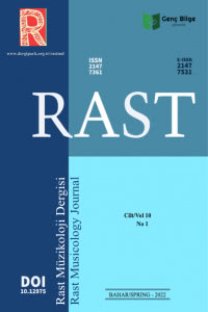The names of the musical instruments in the Turkish translation of Shota Rustaveli’s Poem “The Knight in the Panther’s Skin”
equivalence, musical instruments, the Knight in the Panther’s Skin, Turkish translation
The names of the musical instruments in the Turkish translation of Shota Rustaveli’s Poem “The Knight in the Panther’s Skin”
___
- Akyay, K. (2014). Türk müziği enstrüman adları etimolojisi. (Origins of turkish musical instrument names). Master’s thesis. Kırklareli University Institute of Social Sciences, Kırklareli, Turkiye.
- Çelebi, E. (2003). Günümüz Türkçesiyle Evliya Çelebi Seyahatnamesi. (Book of Travels of Evliya Celebi). (Ed. A. Kahraman, Y. Dağlı).İstanbul: Yapı Kredi.
- Chikobava, A. (1964). Kartuli enis ganmartebiti leksikoni. (Explanatory Dictionary of the Georgian Language). Volume 8. Tbilisi: Metsniereba.
- Nisanyan sözlük (Nisanyan Dictionary) Web site: https://www.nisanyansozluk.com/ kelime/%C3%A7eng
- Nozadze, V. (1961). Vepkhistkaosnis Sazogadoebatmetkveleba (“The Knight in the Panther’s Skin society”). National Parliamentary Library of Georgia.
- Orbeliani, S. S. (1949). Sitkvis kona. (The Georgian dictionary). Tbilisi: Georgian SSR State Publishing House.
- Ögel, B. (1991). Türk kültür tarihine giriş. (Introduction to Turkish Cultural History). Ankara: Ministry of Culture Publications.
- Özegin, M. (1983). Türklerde musiki aletleri. (Turkish musical instruments). İstanbul: Akbank publications.
- Pirgon, Y. (2021). İslamiyet öncesi Türklerde askeri müzik. (Military music in pre-Islamic Turks). Journal of Human and Social Sciences, 4(1), 121-134.
- Şahin, M., & Aslan, E. (2020). Orta-çağ Türk-İslam devletlerinde Nevbet. (Nevbet in medieval Turkish-Islamic states). Amasya University Journal of Social Science, 8, 107- 144.
- Sanal, H. (1964). Mehter Musikisi Bestekar Mehterler-Mehter Havaları. (Mehter Music Bestekar Mehterler-Mehter Havaları). İstanbul: National Education Publishing House.
- Sanal, H. (2002). Kös, İslam Ansiklopedisi. (Kos, Encyclopedia of Islam). Ankara: Türkiye Diyanet Foundation.
- Shanidze, A (1960). Vephkhistkaosani. (The Knight in the Panther’s Skin). Volume 3.Tbilisi: Nakaduli.
- Soydaş, M., & Beşiroğlu Ş. (2007). Osmanlı saray müziğinde yaylı çalgılar (Bowed Instruments in the Music of the Ottoman Court). ITU Journal, 4(1), 3-12.
- Gökçen, I. (2017). Evlia Seyahatnamesi’nde Çalgılar. instruments in Evliya Çelebi’s travel book). Ankara: Ürün Yayınları
- Gurgenidze, N., & Chlaidze, L. (2001). Turkul-kartuli leksikoni. (Turkish-Georgian Dictionary). Tbilisi: Institute of Oriental Studies.
- Hacib, Y. (1956). Kutadgu bilig (the Kutadgu bilig) 2nd ed. (Trans. R. Rahmeti Arat). Ankara: Turkish Language Association
- Javakhishvili, I. (1938). Kartuli musikis istoriis dziritadi sakitkhebi. (Basic aspects of georgian folk music history). Tbilisi: Pederatsia.
- Justrow, M. (1903). A dictionary of the targumim, the talmud babli and yerushalmi, and the midrashic literature. London, New- York: Luzac &co.; G. P. Putnam’s Sons.
- Kaya, M. (1998). Dünden bugüne Rebab ve yeniden ele alınması (From the past to the present Rebab and it’s reconsideration). Istanbul Technical University, Institute of Social Sciences, Istanbul, Turkiye.
- Natadze, N. (2007). Vephkhistkaosani. (The Knight in the Panther’s Skin). Tbilisi: School edition
- ISSN: 2147-7361
- Yayın Aralığı: Yılda 4 Sayı
- Başlangıç: 2013
- Yayıncı: Genç Bilge Yayıncılık (Young Wise)
Music as an inclusion tool: can primary school teachers use it effectively?
Ardita DEVOLLİ, Shqipe AVDIU-KRYEZİU
Azerbaycan'daki düğün törenlerinin çeşitliliği bağlamında Nahçıvan bölgesinin düğün gelenekleri
Nona NİKABADZE, Lile TANDILAVA, Maia BARAMIDZE
Kosovo musicians' efficacy of using English language: Internationalization of Albanian songs
Teuta AGAJ AVDIU, Shqipe MORİNA, Arta TİKA BEKTESHİ, Besa BERİSHA
Çağdaş dönem avangart trombon tekniklerinin kullanımı ve icrası üzerine bir analiz
